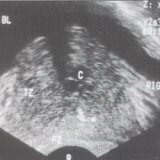Cystic hyperplasia: symptoms and treatment

Hyperplasia of the mucous membrane of the cervical canal is a benign formation characterized by an increase in its volume due to an increase in the number of cells. With the development of contraception and the widespread use of estrogen-gestogen-containing drugs, the study of hyperplasia has become more detailed and in-depth.
The development of various types of hyperplasia is observed in pregnant women, in women who have never taken steroid medications, as well as in people who, in order to treat their illness, have taken gestogen-containing medicines.
The causes of the appearance of hyperplasia have not yet been fully understood.
Hyperplasia can be of several types:
- cystic,
- glandular,
- micellar,
- glandular-cystic,
- atypical microferment.
This article deals with what is cystic hyperplasia: symptoms and treatment.
Cystic hyperplasia of endocervis has differences in comparison with other types of hyperplasia. They consist in the fact that the cystic dilated glands with often flattened single-rowed epithelium are in a significant accumulation and have no signs of polyphery. In this regard, the woman in the cavity of the cervical uterine canal begins to grow cyst.
A cyst is a neoplasm that can appear inside various organs due to a deviation. The cyst has the form of a sac with inner contents.
In the development of this type of disease, the increase in stromal fibroblasts, the force of collagen formation, under the condition of hypoxia associated with stagnation of blood in the veins of the pelvis in general and the cervix in particular, is of great importance. This increase occurs against a background of large uterine fibroids and low-lying nodes.
Symptoms of cystic hyperplasia
In most women, the clinical symptoms of cystic hyperplasia are not observed. And in the event that a woman for a long time is not observed in a gynecologist, she does not even suspect about her existence.
Some patients complain of a symptom such as increased secretion. Another part comes to the doctor with complaints about the meager spotting that occurs during the period between menstruation. There are also patients who had spotting during sexual intercourse.
The patient can immediately have all the symptoms present. Cystic hyperplasia in this case is not always clearly visible.
But most often the clinical symptoms of the disease are due to the woman's gynecological diseases.
These symptoms may include: itching, discomfort during urination, pain or burning during intercourse.
In any case, if there is at least one of these symptoms, you need to see a doctor gynecologist, for diagnosis of the disease and appropriate treatment.
Treatment of cystic hyperplasia
For correct diagnosis and detection of the presence of cystic education, the following:
- gynecological examination of the uterine cavity by means of
- mirrors cytology
- colposcopy
But these methods of diagnosis do not allow to evaluate the whole picture of the change in endocervis. Therefore, usually as an addition to the above methods, scraping of the mucous membrane of the cervical uterine canal and cervix is performed. This material is sent for histological examination. In addition, ultrasound is widely used.
There are often situations where scraping of the surface of the tsevirkal canal with the purpose of diagnosis leads to the removal of cystic formation and as a consequence, the pathological process in the woman's body is eliminated.
However, if this does not happen, a treatment is prescribed. Cystic hyperplasia is treated taking into account the fact that the disease has a hormone-dependent function.
Most often, various phytosbores and phytotherapeutic preparations that have hormone-like effects are selected for treatment of the patient. In the case of cystic education, it should be drugs that carry progesterone and estrogen into the body. This method of treatment does not give any side effects and has a fairly mild effect. Usually the course of herbal medicine lasts three months.
A more severe form of treatment is hormone therapy.
In reproductive and pubertal age, the ultimate goal of cystic hyperplasia is to restore cycles of ovulation. In menopause, treatment has the character of suppressing menstrual function. Recently, the possibilities of this kind of therapy have expanded significantly, although its principles have not changed. As before derivatives are used:
- androgen,
- progestogen.
Successful application have:
- norethisterone,
- gestrinone,
- Norcolut;
- danazol;
- is a synthetic agonist.
In the treatment of cystic hyperplasia, patients who are in reproductive age are prescribed a course of taking estrogen-gelogenic drugs, which include single-phase and two-phase contraceptives.
Drugs based on gestogens may also be prescribed. These drugs include:
- Norcolut,
- 17-OPK,
- Dufaston, etc.
The duration of the course of hormonal drugs is selected in accordance with the nature of the hyperplastic process. In cystic hyperplasia, the use of estrogen-progestogen is prescribed from the fifth to the twenty-fifth day of the cycle. The course usually lasts for 3-4 months. At the same time, from the 25th day after the menstruation and on the 5th day after the end of the next in the reception of the drug, a break is made.
For the treatment of small cystic education in women of reproductive age, non-hormonal drugs are used. Such non-hormonal drugs include tamoxifen, which is usually used in oncology for the treatment and prevention of metastases and relapses. This drug has similarities with clomiphene.



